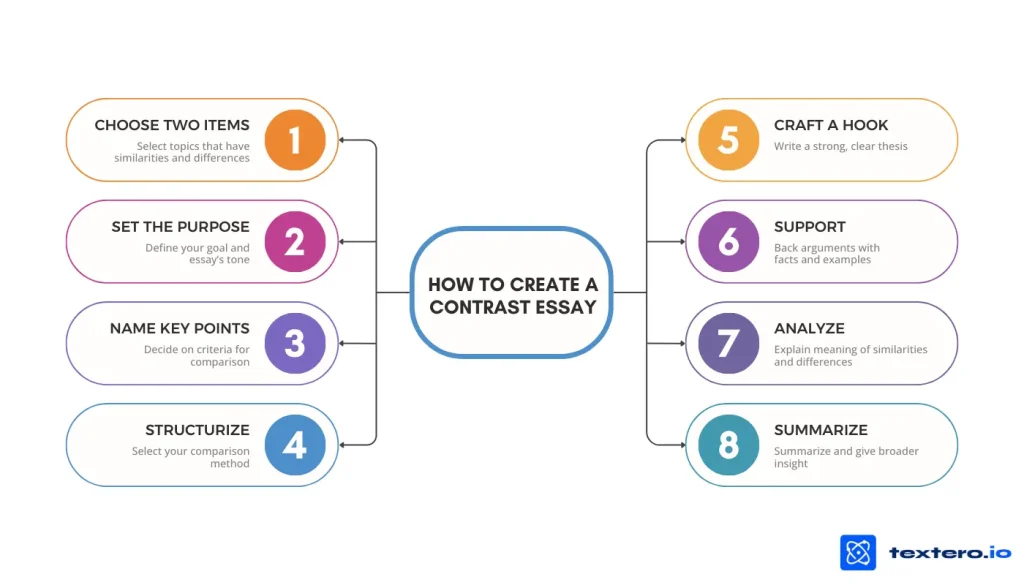How to Write a Compare and Contrast Essay

Today, a compare and contrast essay is a common assignment used to help students develop critical thinking skills, but how do you write a compare and contrast essay if you are not yet familiar with this type of writing? Here, we will shed some light on how to craft a masterpiece even if you are not familiar with this type of writing.
Compare and contrast essays are pretty important for young adults because they teach them to look beyond the basics and organize their thoughts effectively. Whether you are being asked to compare theories or historical events, the goal is to draw meaningful connections and provide insights.
In this article, we will share some tips on how to write a compare and contrast essay that will be well-researched, be clear to your readers, and meet all the academic requirements. So, proceed with reading and get this tough task done!
When to Use Comparison and Contrast in Your Writing
As we have already mentioned, a compare and contrast essay is an inevitable part of the academic journey. This type of writing is pretty popular because it helps one develop a large pool of skills. Thus, we have organized this section to help you understand the nature of a compare and contrast essay, what you may need to compose it, and what issues it can cover.
Assess two items. Identify similarities and differences and offer readers a balanced evaluation to help them deepen their understanding and form their own opinions or judgments.
Make a decision. A compare and contrast essay is a perfect tool when you need to choose between two options. By knowing how to compare their features and weaknesses side by side, you can identify which one meets your needs best.
Highlight distinctions. Unpack the small but meaningful differences between similar subjects, as doing so may provide you with detailed insight that might be missed in a general discussion or a certain analysis.
Find connections. Compare themes and find out how different ideas relate to or influence each other. This way, you can enrich the reader’s comprehension of the subject.
Present the evolution. Contrasting past and present versions of a topic will reveal how and why changes occurred and help you track the shifts over time that could be meaningful in understanding the overall concept.
Analyze perspectives. Boost your critical thinking by outlining each stance’s merits and drawbacks without bias.
Strengthen your argumentation. In a compare and contrast essay, you may be required to contrast your position with an opposing view, which can help clarify your argument’s strengths. As a result, you will learn to convince readers through writing.
Understand subjects. A compare and contrast writing task is a common thing in subjects like literature, science, and history which helps students uncover patterns, deepen comprehension, and connect abstract concepts with real-world examples when they are comparing theories, characters, or events.
Offer a unique point. Well, why not try creative comparisons? You can compare anything. From cats vs. dogs to city life vs. rural living, be creative and think about what can help you engage and inform your audience.
How to Create Meaningful Comparisons
If you ask yourself, “How do I write a compare and contrast essay that is meaningful?”, the main idea is to make it go beyond listing similarities and differences, providing insight into the relationship between the two subjects. Provide readers with a clear perspective of or informed judgment on the topics covered in your writing. Here are the steps we recommend following in order to come up with a strong comparison essay.

Step 1: Choose two items
So, how do you start a compare and contrast essay? Select topics from the same category that have similarities and differences.
- Ask yourself, “Do these subjects have enough in common to compare and enough differences to contrast?” If yes, you’re on the right track.
Step 2: Set the purpose
Clarify why you are going to compare these particular subjects and tell your readers whether you are going to evaluate the items or (maybe) inform or entertain them. Having a focused purpose, you can easily shape the tone of your piece.
- Write a purpose statement like, “This essay will compare X and Y to determine which is more effective,” and refer back to it throughout the writing process.
Step 3: Name key points
Highlight the aspects you’ll compare and keep in mind that these criteria should be relevant to your purpose and offer enough depth.
- You can add a comparison chart to brainstorm similarities and differences that can help you see the strongest angles for analysis.
Step 4: Choose a structure
Decide between the point-by-point method (alternating between subjects) or the block method (discussing one subject fully, then the other).
- We highly recommend using point-by-point for detailed analysis and block format for simpler comparisons.
Step 5: Craft a hooking statement
Your thesis should reflect the main conclusion drawn from your comparison. It is your hint that will tell your audience what to expect in the end.
- A statement that sounds like “X and Y are different” is likely to fail, so try something like “While X emphasizes creativity, Y values tradition, making X more appealing to modern audiences.”
Step 6: Support each point
Back up your comparisons with facts, examples, and relevant data because these will add credibility and strengthen the entire analysis.
- Use the same kind of evidence for both items; when referencing a source for one issue, include a similar type of support for the other.
Step 7: Analyze (but don’t just describe)
Discuss what the differences or similarities mean and why they matter. This will deepen your argument and make the whole essay meaningful.
- Asking yourself a question like “So what?” after each comparison can help you explain the significance of what you’ve presented.
Step 8: Write a conclusion
Restate the thesis and emphasize the broader insight, but avoid repeating earlier points word-for-word. Well, if you are struggling to meet the word limit or lack words to provide all the essential ideas, feel free to expand text with the help of our AI tool and make things easier and faster.
- End with a reflection; suggest what readers can learn or how the comparison impacts a larger context.
Using Compare and Contrast to Generate Ideas
Even though a compare and contrast essay is a widely popular type of writing in the academic scene, because of the large number of skills a college student can develop when working on their project, it is also a pretty popular technique that can help you come up with a fresh idea for any kind of academic writing, presentation, or even speech. Well, if you are wondering why this type of writing is so useful, here are some ways in which you can benefit from it in both your personal and academic life.
- Spot gaps in knowledge. A comparison of two subjects can highlight what one includes that the other lacks. These gaps can lead to new questions and unexplored angles that can serve as fresh starting points for future writing.
- Create surprise. By contrasting issues, you can find unexpected differences that can challenge common beliefs. This tension can inspire engaging ideas as well.
- Reframe topics. A comparative approach can help you take a well-known subject and explore it from a brand-new angle, and as a result, lead to innovative ideas.
- Combine unlikely pairs. Placing two seemingly unrelated ideas side by side can spark creative thinking. If possible, why not make connections where none are obvious? Such an attitude often leads to novel insights or interdisciplinary perspectives.
- Challenge assumptions. Compare subjects and find out if one challenges the effectiveness of the other. This critical approach may lead to ideas that question the status quo and encourage deeper analysis.
Organizing Your Comparison Essay for Clarity
Of course, as with any kind of writing, you may wonder how to set up a compare and contrast essay. Well, it is important to organize your thoughts effectively to reach every reader and help them fully understand your ideas. Thus, here are some tips that can show you how to write a compare and contrast essay that will be both informative and clear to your audience.
- Use a clear structure
Choose between point-by-point and block format to give your writing a predictable flow as well as helping your readers understand how each idea connects to the others. Following a certain structure format, you are more likely to stay organized throughout the entire paper.
- Craft an outline
Create a detailed outline before you start the writing process and create headings for each comparison point. This way, you will have a clear roadmap for presenting your ideas and arranging them logically.
- Choose a focused statement
With a precise thesis statement, you have to outline what you’re comparing and why. It will guide your essay’s direction and keep each paragraph relevant. As a result, you will be sure that all the points contribute to the main purpose.
- Follow consistent comparison criteria
Apply the same categories or aspects to both subjects. It means that when analysing the cost, function, or impact of a certain item, you have to dwell upon the same aspect when dealing with the opposite subject. This will help your readers follow the discussion and evaluate each subject on their own.
- Offer clear topic sentences
Start each paragraph with a sentence that tells readers what you are going to compare in this section. This way, you will improve organization and make sure each paragraph stays focused.
- Group similar ideas
Place related comparisons in the same paragraph in order to avoid confusion and make your essay easier to read. Having such a logical relationship between points will help you maintain a smooth flow. But still, avoid mixing multiple loose comparisons in a single paragraph to keep the structure clean.
- Use transition words
Don’t forget about including phrases like “similarly,” “in contrast,” or “on the other hand” to guide the reader. These cues will definitely help you clarify the relationships between ideas and create smooth shifts from one point to the next.
- Use visuals
Tables, charts, and/or diagrams are your secret weapon for simplifying complex comparisons. With these simple tools, you can make relationships between subjects clearer as well as break up dense text. So, if you are mulling over how to supplement an organized and engaging essay, don’t hesitate to use visuals.
- Avoid redundancy in repetition
If you are using a point-by-point structure, don’t repeat basic similarities or differences unnecessarily. Instead, focus on meaningful comparisons to keep content concise.
- Summarize the key points in the conclusion
Wrap up your writing by summarising the main comparisons and their significance. This way, you will tie everything together as well as reminding readers of the essay’s overall purpose. Remember that your conclusion must be the answer to the thesis statement you presented at the very beginning.
A compare and contrast essay is a type of writing that you will frequently face during your academic journey because it is one of the types of writing that shapes your professional skills, which are crucial for your future career. So, we hope this article helped you understand how to write a compare and contrast paper that rocks and shows your professional attitude on the subject. Remember that if you have problems with writing, our advanced tools, like an AI literature review writer and an AI fixer, are always here at your disposal to help you handle any kind of writing issue with ease.





